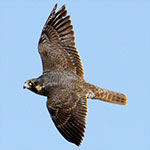 The final tally for October peregrine sightings from the Florida Keys Hawkwatch was 3,817 on October 31.
The final tally for October peregrine sightings from the Florida Keys Hawkwatch was 3,817 on October 31.
An interesting note from Florida Keys Hawkwatch, the new Peregrine Falcon “capital of the world.” On October 16 at 14:49 the 3220th Peregrine was tallied for fall 2012, breaking previous seasons' records.
By the end of the day, the new season total at Florida Keys stood at 3242. On October 17th the site on Little Crawl Key added 27 more Peregrines, so the current total stands at 3269.
Along the way to this historic number, the site also broke its own previous high daily count for Peregrines, tallying 651 Peregrines on October 10. The previous daily record was 638 set on October 11, 2008 at the site, which was then named Curry Hammock.
-----------------------------------------------------------------------------------------------------------------------------------------------------------------------------------------------
The number above doesn’t really represent a migrating population of 3,817 peregrines at that observation point. Typically, migratory peregrine populations are simply reported as being equal to the number of falcons observed. This method of estimating the size of the peregrine population substantially under estimates the actual number of peregrines; and most of the biologists using this data know it.
So what is the real population size?
There are some well established population metrics relating to migrant North American peregrines which are supported by very solid historical field data:
1) Large numbers of taiga and arctic peregrines migrate past locations such as Assateague Island, CapeHatteras, Padre Island and the Florida Keys each fall.
2) The age and sex group of migrant peregrines observed at these locations is predominantly immature females.
3) The observed populations consist of about 45% immature females, 15% immature males, 33% adult females and maybe 7% adult males. Immature males, and adults of both sexes don’t follow the same migration paths as immature females.
4) The male/female sex ratio in peregrines is 1:1.
5) For North American taiga and arctic peregrines, the number of young produced per starting pair is reported to be an average of 0.9 to 1.1y/pr.
6) There is a non-breeding adult “floater”, and sub-adult population which is at a minimum 30% of the breeding adult population. (Recent estimates for RockyMountain anatums in Montana is >50% adult and sub adult floaters).
7) At most 1/3 of the North American migrant peregrine population transits the Florida Keys each fall.
Any competent population biologist familiar with the use of statistical tools such as the Lincoln Index, and in possession of the basic data relating to peregrines listed above would reasonably conclude that the proper way to estimate the migrant peregrine population would be to base the estimate on the number of immature females observed (the most plentiful age group) and extrapolate the size of the total population based on the number of immature females, and other well established population metrics. This is a valid premise, and produces dramatically different population estimates:
Using these percentages, the total number of immature females observed was about 1,718. (3,817)(0.45) = 1,718. 45% or 1,718 are immature females.
There are as many males as females hatched each year so the immature population is actually 2,942, which is 150% higher than reported. (1,718 immature females)(2) = 3,435 immature peregrines
If the average #young per starting pair is 1.1, then there had to be 3,123 breeding pairs (3,435 immatures)/(1.1) = 3,123 breeding pairs.
3,123 Breeding pairs represents 6,246 breeding adults.
If the number of adult floaters and sub adults is 30% of the breeding adult population (a very conservative estimate) there are 1,874 non-breeding adults. (6,246)(0.3) = 1,874
So, the total population size of the peregrines migrating over or near the Florida Keys in 2012 is: (3,435 immatures) + (6,246 breeding adults) + (1,874 adult floaters) = 11,555 peregrines, or 3X the number actually observed/reported.
This estimate is based on the number of immature females observed migrating past one very small area in the Florida Keys, which is in reality, a small fraction of the total North American migrant peregrine population.
Taking into account the large numbers of peregrines seen at other migration points during this time of year, I would realistically estimate the total fall migrating population of tundra and taiga peregrines at 30,000 to 40,000 individuals, of which about 30% are immatures, or 9,000 to 12,000 total immatures.
The current EA recommended 5% harvest of the immatures would amount to between 450 to 600 peregrines per year.
And we get 36 at this time.
Peregrines, both the migrant arctic and continental populations, are very clearly not a species of concern at this time and do not warrant any more management considerations or concern relative to their use in falconry by Federal Wildlife authorities than do redtailed hawks or prairie falcons, and their use in falconry should be managed in essentially the same way by the several states.
Lee R. Grater
Master Falconer
BS Biology, ColoradoStateUniversity (emphasis raptor biology)
Enid, Oklahoma
